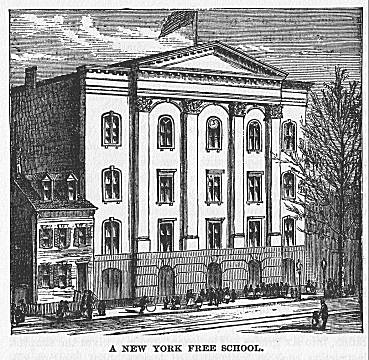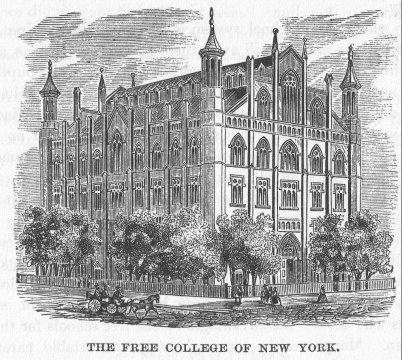
This is historical reference material from the public domain book titled “Lights and Shadows of New York City Life” by James McCabe. The information below focuses specifically on the free and public school systems of New York City in the 1800’s. If you enjoy the information below you are more than welcome to download or read the complete Ebook of “Lights and Shadows of New York Life” by clicking the link at the bottom of this post.
The provision made by the city and the people of New York for the education of the young is in keeping with their metropolitan character. The public and private schools are numerous, and are well supported.
The first in importance are the Public or Free Schools, which are acknowledged to be the best in the Union. The Free School system is under the control of a Board of Education, whose offices are located in a handsome brown stone building at the northwest corner of Grand and Elm streets. The Board consists of twelve Commissioners, who have the general supervision of the schools, the disbursement of the moneys appropriated for the cause of education, the purchase of sites and the erection of new buildings, the purchase and distribution of books, stationery, fuel, lights, and all supplies needed by the schools. There are also five Trustees for each ward, or 110 in all, who were, until recently, chosen by the people. Besides these, are twenty-one Inspectors of Schools, who were, until recently, appointed by the Mayor and confirmed by the people. The charter of 1870, however, changed the whole system, and gave to the Mayor the power of appointing all the officers named above, taking the control of the school system entirely out of the hands of the people. It is needless to add this was the work of the Ring, and was done to secure to them additional power and plunder.
There are about one hundred buildings in the city used by the public schools. About eighty-five of these are owned by the city; the others are rented. The property under the charge of the Board of Education is valued at more than $10,000,000. The annual expenditure for the support of the schools averages $3,000,000. In 1869 it was $3,136,136. Of this sum, $1,759,634, represented teachers’ salaries; $41,908, was for the support of the colored schools; and $164,717, was for the purchase of school apparatus, maps, globes, blackboards, books, etc. The teachers employed in the public schools number 2500, a large proportion being women, The average annual attendance of pupils is 225,000.
The school buildings are generally of brick, tastefully trimmed with brown stone, though some of those more recently erected are entirely of brown or Ohio stone. They are among the most handsome edifices in the city. They are generally four stories in height, with a frontage of 100 or 150 feet. All that were erected for the purpose are commodious and comfortable, though the more recent structures are the best arranged. They are provided with every convenience for teaching, and for the comfort of both teacher and pupil. Some of them cover two city lots, while others occupy as many as six of these lots. Some will accommodate as many as 2000 pupils, and these large buildings have been found to be more economical than small ones. Each is provided with several fire-proof stairways, and each is in charge of a janitor, who resides in the building. The entrances for pupils are at the sides of the building. Visitors enter through the large door in the centre.
The public schools are divided into Primary, Grammar, Evening, and Normal Schools. There are about 200 of these schools in the city, a Primary and a Grammar School often occupying the same building. Some of the Primaries are for boys or girls only, while in others both sexes are admitted. The course in the Primaries is very simple, as very young children are taught here. The pupils are divided, according to qualification, into six grades. The lowest grade receives the simplest instruction, such as conversational lessons about common objects, or “object teaching,” which is designed to form habits of accurate observation; simple instruction in regard to morals and manners; reading and spelling easy words from the blackboard or chart; counting; and simple addition by the aid of the numerical frame. From this simple, but substantial basis, the pupil is advanced as rapidly as his capabilities will permit, from grade to grade; until the first, or highest, is reached. In this the instruction embraces the four ground rules of arithmetic, geography, writing, drawing on the slate, and advanced object lessons. When the pupil is proficient in these studies, he is transferred to the Grammar School.
The Grammar School takes up the course where it is dropped by the Primary, and gives to the pupil a sound and practical “common school education.” It embraces in its various grades, such studies as English grammar, history, astronomy (in its simpler form), physical geography, composition, drawing, and book keeping, besides the simpler studies of the lower grades which were begun in the Primary School.
Girls who are found proficient in the Grammar School course, are advanced to the Normal School, which is temporarily located at the corner of Broadway and Fourth street. Here they may enjoy the benefits of a course as thorough and extended as that afforded by the Free College.
Boys who have attended the Grammar Schools for a certain period, and are found proficient in the course taught there, are promoted to the Free College of the city of New York. This noble institution is located at the southeast corner of Lexington avenue and Twenty-third street. It is a handsome edifice of brick, stuccoed in imitation of brown stone, and was founded in 1848. The President is Horace Webster, LL.D., and the faculty includes some of the ablest men in the country. The course taught here is full and thorough, and is about the same as that of the best colleges in the land. The entire expense of the Female Normal School, and the Free College is borne by the city.
The whole public school system is free to all the children of the city, whose parents will avail themselves of it. Books, and everything needed, are furnished without charge. The pupil is put to no expense whatever, but is required to maintain habits of order and personal neatness. The cost to the city is gladly borne by the tax payers, for it saves the metropolis from an increase of the great army of ignorant and idle men and women, which are the curse of all great cities. The very poorest men or women can thus give to their children the priceless boon of knowledge, of which their youth was deprived. Profiting by the advantage thus acquired, these little ones, in after years, may rise to fame and fortune. Thus not only the metropolis but the whole country reaps the blessings of this magnificent system of free education. The poor, however, are not the only persons who secure the advantages of the free schools for their children. Many wealthy, or moderately comfortable parents send their children to these schools, because they are the best in the city.
Connected with the day schools, there are twenty-seven evening schools, with an average annual attendance of 20,000 pupils. These are designed for the instruction of those whose avocations or age prevent them from attending the day schools. Only simple studies are taught in these schools. The pupils consist of cash boys, clerks, porters, and laboring men and women. Many of them are foreigners, who come to learn the English language. The adults show as much eagerness to learn as the younger pupils. All are generally neat in person, though their clothing may be rough and worn. Sometime ago, a member of the Board of Education, in addressing one of these evening classes, dwelt especially upon the necessity of cultivating habits of personal neatness. It happened that there were several men present, whose appearance indicated that they had come directly from their work to the school. One of them arose, and offered the following excuse for their appearance. He said, “We don’t always come to school in this way, but we were at work in the yard pretty late, and had no time to go home for supper even, as we didn’t want to be late at school; and not expecting any visitors, we made up our minds to come as we were. The Principal knows us, and we knew he would excuse us for coming so.”
An Evening High School, for males only, has been established, at which working men, and others unable to attend the day schools, may pursue a more extended course of study. English grammar, mathematics, natural science, drawing, navigation, municipal and constitutional law, phonography, declamation, book-keeping, Latin, French, German, and Spanish are embraced in the course. The students may pursue one or more studies, as they may desire.
Read or download the FREE Ebook “Lights and Shadows of New York City Life” by James McCabe by clicking or right-clicking the link below:


